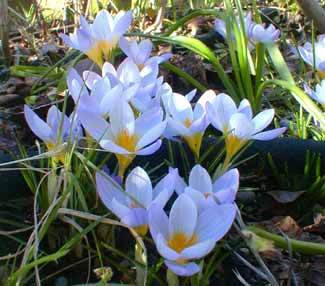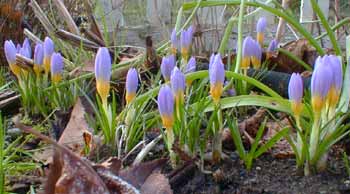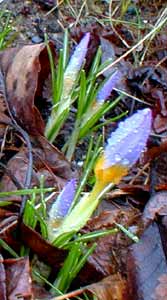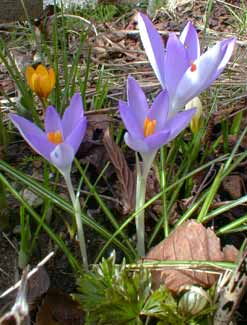
'Firefly' Snow Crocus
"Already the slim crocus stirs the snows."
-Oscar Wilde,
Humanitad
Humanitad
Crocus sieberi atticus 'Firefly' was developed by M. Thoolen of Overveen, The Netherlands. It is the single most popular crocus of its species.
We have it planted in a large loose drift covering about two by four feet underneath the Oyama magnolia & around the base of a Bleedingheart.
When this Snow Crocus is in full bright bud no later than the third week in January, the Oyama is still leafless, & the Bleedingheart has not yet begun its spring return, so the crocuses have the whole area with plenty of dappled afternoon sunlight reaching them through naked branches.
 They will also bloom in considerable shade if they have to, but will only open completely wide when full sun is upon them.
They will also bloom in considerable shade if they have to, but will only open completely wide when full sun is upon them.A few of January buds of these winter bloomers will open well before month's end, but they are most flowery for the whole of February, with the last of an impressive drift still appealing in early March, with a few vagrant late-bloomers at mid-March. But even before they open into full flower, the two or three inch tall blue to mat-lilac buds with yellow bottoms are already extravagant in their own small way, so that counting the preliminary color of just the buds, 'Firefly' lasts six or seven weeks, for quite a long late-winter presence.
However, in some years, if rainfall is hard & longlasting & timed "just wrong," many of the earliest crocuses get prematurely beaten to pieces. 'Firefly' is usually reliable, & I had gotten used to their perfection year after year even when some more delicate crocuses were ruined by late-winter rainfall. But one year out of four (in 2005) even 'Firefly' was beaten to bits by a storm, almost as soon as the buds opened.
 Occasional disappointment has to be expected, & some years the majority of crocuses will do great, other years many of them will be ephemerals showing themselves at their best for scant days. The real trick is to have crocuses of one kind or another opening every week so that some of them, even when not all of them, will shine to maximum glory on the sunnier days. Also to ward off disappointment on particularly rainy-winter years, dwarf reticulated irises which also bloom at winter's end will remain fully open even on overcast days, & are rarely beaten down by rainstorms.
Occasional disappointment has to be expected, & some years the majority of crocuses will do great, other years many of them will be ephemerals showing themselves at their best for scant days. The real trick is to have crocuses of one kind or another opening every week so that some of them, even when not all of them, will shine to maximum glory on the sunnier days. Also to ward off disappointment on particularly rainy-winter years, dwarf reticulated irises which also bloom at winter's end will remain fully open even on overcast days, & are rarely beaten down by rainstorms.The first three photos on this page are all from February (2004). The second photo shows them not as buds, but re-closed into the shape of buds on an overcast day. The third photo shows a couple actual buds behind a closed full flower.
Even half-sleeping under cloudcover, or at dawn & dusk when even on brighter days they'll be closed, their snaky heads are gorgeous. For the most part they are sufficiently strong-stemmed to remain upright whether snake-headed on cloudy days or open goblets on sunny days.
We've some varieties of yellow crocuses that get a jump on 'Firefly' & bloom one to three weeks earlier, but 'Firefly' is our earliest crocus in the blue-lilac-purple color range.
The species is native from the Balkans to mountains of Greece & really prefers cool climates. Our Zone 8 is about the warmest they enjoy, but will do nicely down to Zone 3, though of course further north they will bloom in spring rather than winter.
 The flowers reach four inches tall & are relatively large. They open a radiant lilac-blue with yellow center. These very easily naturalize & return year after year pretty much forever.
The flowers reach four inches tall & are relatively large. They open a radiant lilac-blue with yellow center. These very easily naturalize & return year after year pretty much forever.We've noticed that some of the self-seeded 'Firefly' crocuses are shorter than the ones originally planted, & have a tendency to bloom two or three weeks later, being the ones that last longest into March. There are a few 'Firefly' crocuses that have erupted some distance from the main drift & these all bloom a bit later, & some get taller rather than remain shorter than the average size within the main drift.
Usually the ones that self-seeded look exactly like their parents even if shorter or taller or blooming a couple weeks later. But occasionally these youngsters show enough variation that it makes us wonder if they were seeded by 'Firefly' or something else, though there's really nothing else in that shade of lilac-blue they could be.
A couple of these vagrant variants we have dubbed our 'Mystery Fireflies' because they lack the yellow bottom. The final portrait shows some of these variant blooms. It is such a pure lilac-blue with no yellow (except for the anthers) that they look more like Crocus pulchellis, but can't be because those bloom in autumn.
Several C. sieberi cultivars exist, but only two are commonly available: 'Tricolor' (yellow, white & lilac) & 'Bowles White' (white with yellow interior), the latter harder to convince to naturalize so only a distant-third in popularity.
There are many other late-winter crocuses commonly designated Snow Crocuses, & we add more varieties of these every autumn, so that late winter is a riot of color well before the main perennials are growing back. For an overview of the varieties we have so far, see the addendum page of More Snow Crocuses.